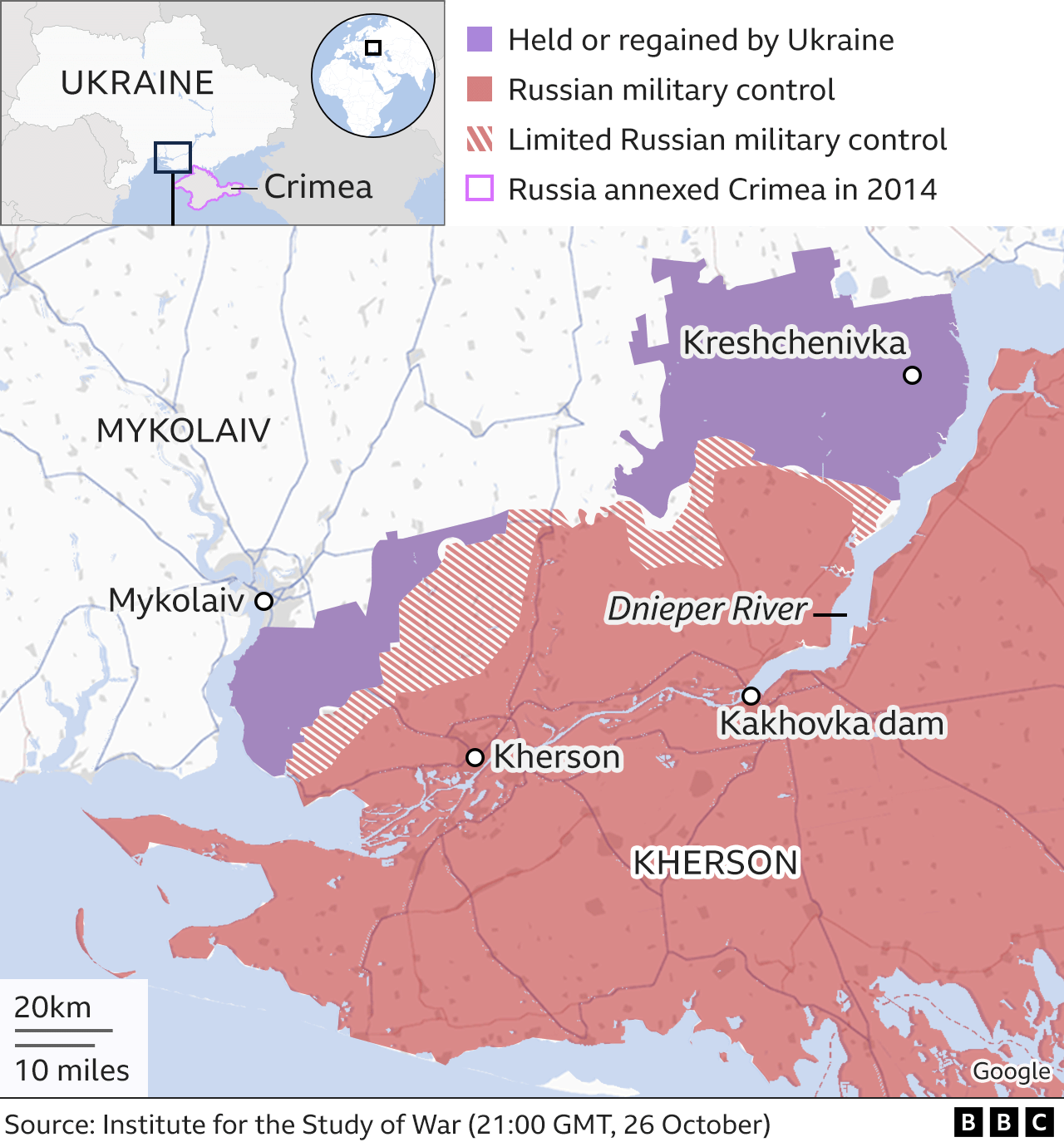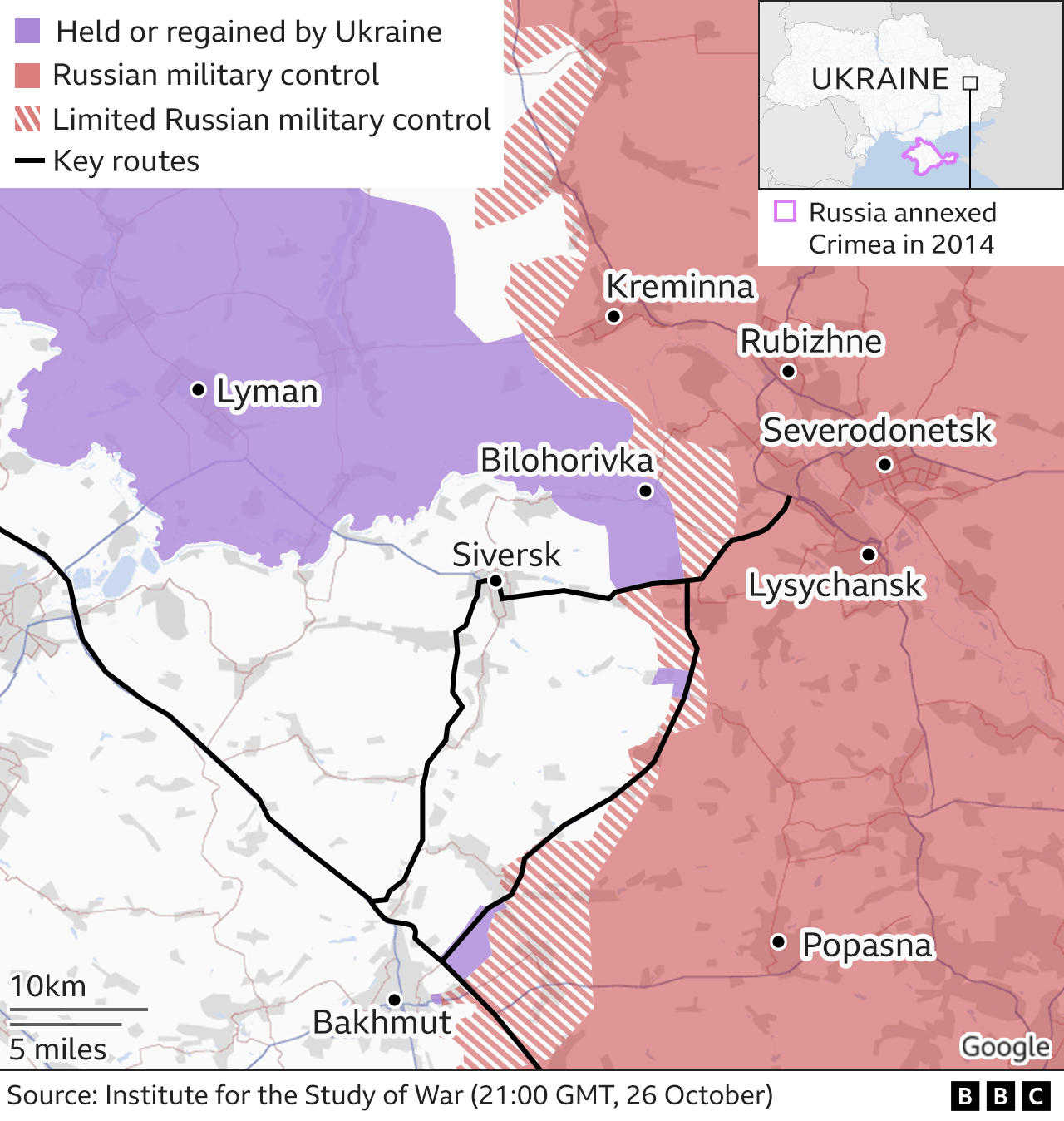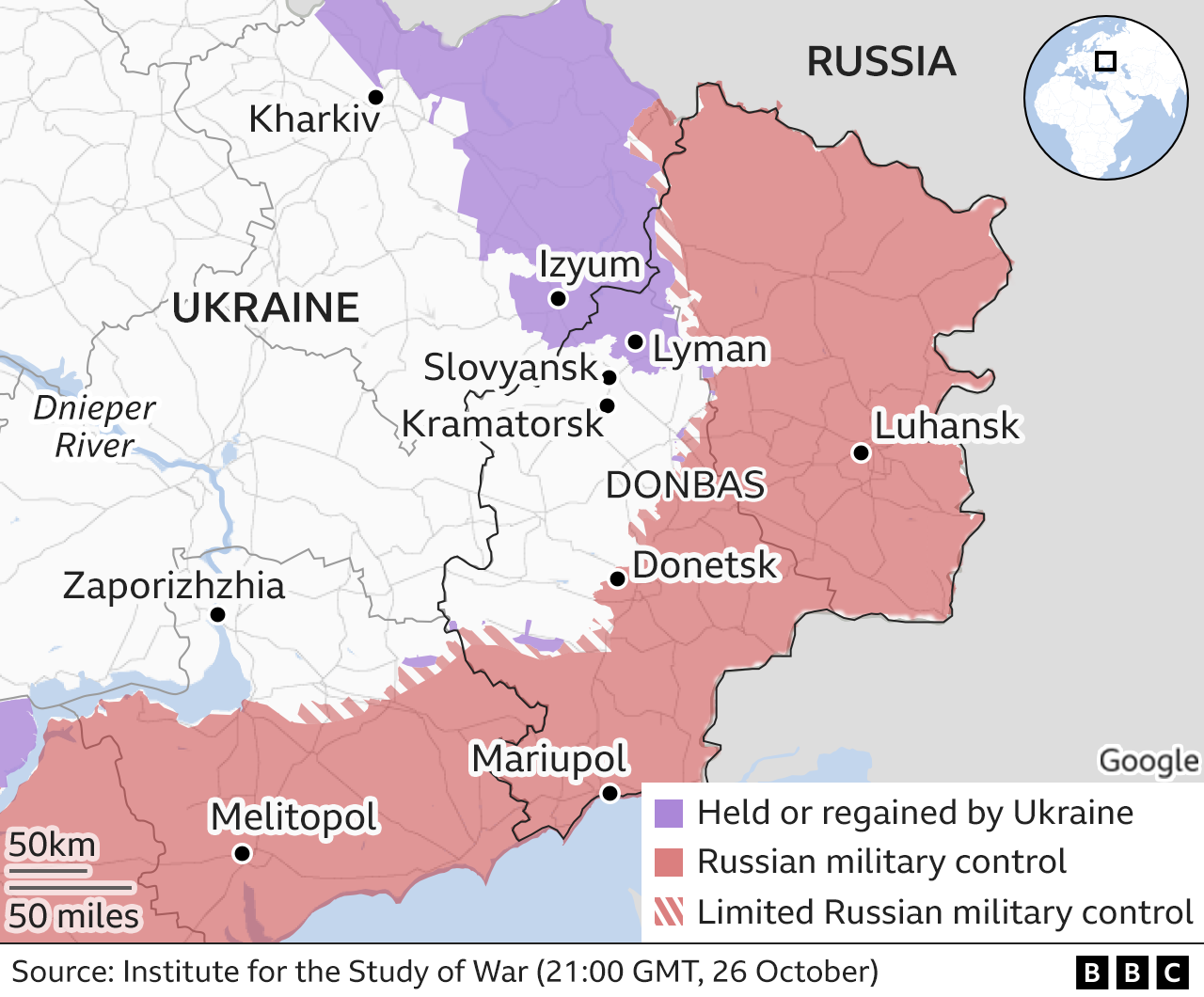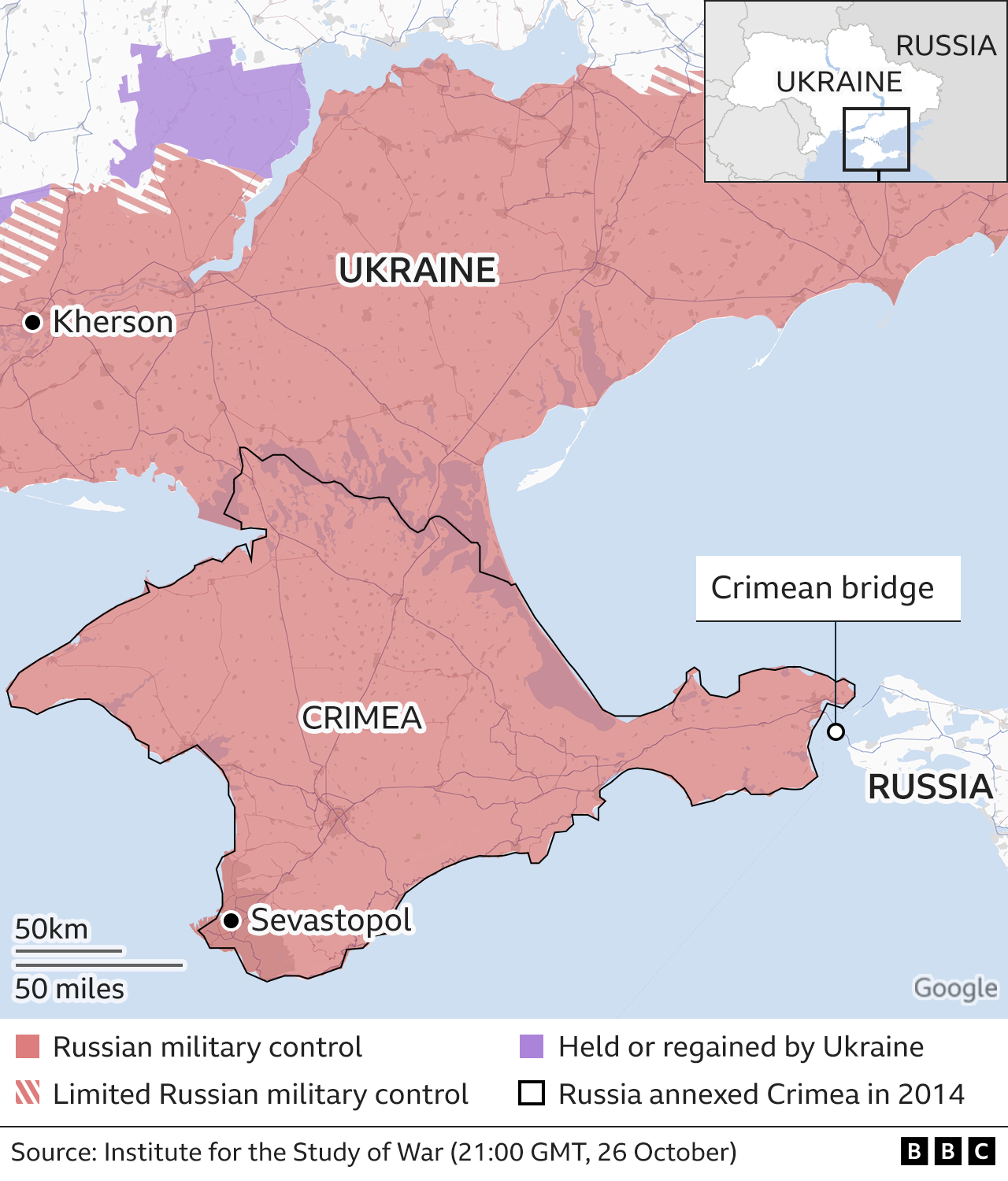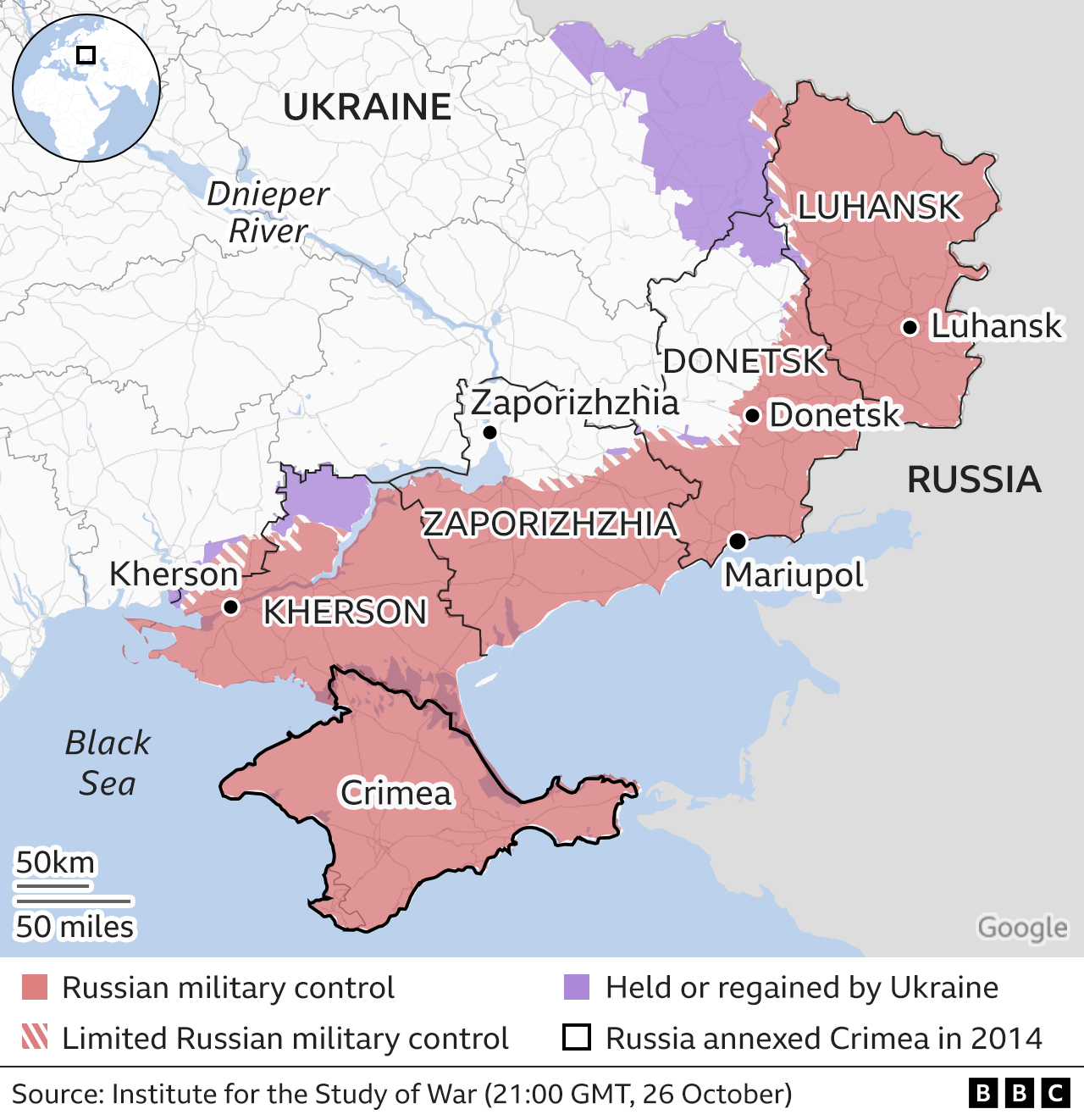BBC News 27 October 2022
Russia is preparing defensive positions across the Kherson region in anticipation of further Ukrainian advances in the south.
Here are the latest developments:
Ukraine pushing forward in the south
Ukrainian troops have continued to advance after breaking through Russia's defences on the west bank of the Dnieper River in Kherson.
Russian-installed officials in Kherson are evacuating civilians to the east bank of river.
The evacuation may be in support of Russian plans to blow up the Kakhovka dam to cover their withdrawal, according to the Institute for the Study of War (ISW).
In recent days Russian forces have been building fortifications and defensive lines in the city of Kherson and Nova Kakhovka, which lies on the river's east bank
Ukrainian troops have been attacking bridges, ferries and pontoons in recent weeks, attempting to make Russian positions on the west side of the river unsustainable, and thereby force a withdrawal.
Also in the south, the International Atomic Energy Agency (IAEA) has called for the demilitarisation of the Zaporizhzhia nuclear power plant.
Russian and Ukrainian sources have accused each other of shelling close to the plant, which is Europe's biggest nuclear facility.
Russia's military took over the power station in early March, but it is still being operated by Ukrainian staff.
Intense fighting in the east
Ukrainian troops took control of the key logistical hub of Lyman in Donetsk at the beginning of October and have continued to push further east towards the region of Luhansk.
The ISW says they have "made substantial gains" in the area, with Russian reports suggests their next target may be the city of Kreminna.
Analysts say the loss of Lyman was a major set-back for Russia.
Russian forces have been trying to push forward in Bakhmut, but reports suggest they have been repelled by Ukrainian troops.
The latest fighting follows a major Russian defeat in the east.
Ukraine says it recaptured 6,000 sq km (2,317 sq miles) of territory from Russia in early September, when it forced back Russian units in the Kharkiv region.
Russian troops withdrew from the key towns of Izyum and Kupiansk, saying that the retreat would allow its troops to "regroup".
Both towns were major logistical hubs for Russian forces in Donbas.
Ukraine's power grid under fire
Earlier in October, Russia appeared to shift tactics, targeting Ukrainian cities further from the frontline, with missile strikes for the first time in months.
Russian forces used Shahed-136 drones recently purchased from Iran in the attacks, as well as ballistic and cruise missiles.
Attacks on Ukraine's energy infrastructure by Russian forces have triggered blackouts in major cities.
Ukraine's President Volodymyr Zelensky says energy facilities in Kyiv, Lviv, Dnipro, Vinnytsia, Zaporizhzhia and Kharkiv are among the places hit.
The latest Russian attacks come after Russian President Vladimir Putin accused Ukraine's security services of attacking the Kerch bridge in Crimea.
Ukrainian officials have not indicated whether their forces were behind the attack.
The 19km (12-mile) bridge, the longest in Europe, is an important supply route for Russian forces fighting in Ukraine.
Russia has used the bridge to move military equipment, ammunition, and personnel from Russia to battlefields in southern Ukraine.
Mr Putin described the blast as an "an act of terrorism aimed at destroying Russia's critical civilian infrastructure".
Russian authorities partially reopened the roadway part of the bridge hours after the attack but for light traffic only.
The railway part of the bridge - where oil tankers caught fire - has also reopened.
Annexation of four regions
Four regions of Ukraine, that are partially or almost completely occupied by Russia have been annexed by the Russian Federation.
It follows self-styled referendums in Donetsk, Luhansk, Kherson and Zaporizhzhia, held between 23 and 27 September.
President Vladimir Putin has said that Russia will use "all the forces and resources" it has to "liberate" the four regions.
In an address to the Russian people, Mr Putin said his country had "various weapons of destruction", adding: "I'm not bluffing."
Russia invaded Ukraine on 24 February, but Ukrainian forces retook large areas around Kyiv in early April after Russia abandoned its push towards the capital.
Areas in the west of the country, including Lviv, have seen missile attacks but no attempt by Russian forces to take and occupy ground.
The Russians have suffered heavy losses since the invasion began and significant quantities of Russian weaponry have also been destroyed or captured.
By David Brown, Bella Hurrell, Dominic Bailey, Mike Hills, Lucy Rodgers, Paul Sargeant, Alison Trowsdale, Tural Ahmedzade, Mark Bryson, Zoe Bartholomew, Sean Willmott, Sana Dionysiou, Joy Roxas, Gerry Fletcher, Jana Tauschinsk, Debie Loizou, Simon Martin and Prina Shah.
About these maps
To indicate which parts of Ukraine are under control by Russian troops we are using daily assessments published by the Institute for the Study of War with the American Enterprise Institute's Critical Threats Project.
To show key areas where advances are taking place we are also using daily updates from the UK Ministry of Defence and BBC research.
The situation in Ukraine is fast moving and it is likely there will be times when there have been changes not reflected in the maps.


